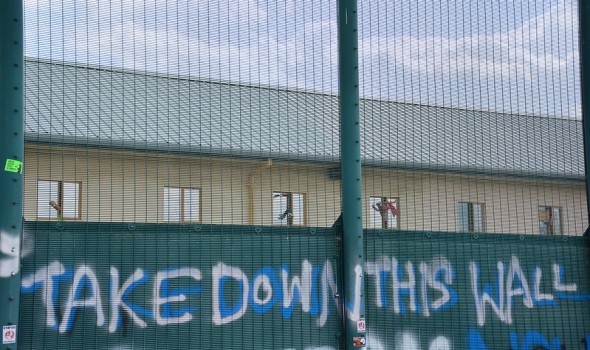Welcome centres not detention centres
Welcome centres not detention centres

Migrant Voice volunteer Helen Davey explores the carceral architecture behind the UK immigration system's way of housing and detaining migrants - and why detention centres shouldn't exist.
The UK’s system of housing and detaining migrants is rooted in hostile architecture and poor design. This includes inadequate accommodation and the deliberate placing of vulnerable people in buildings on the peripheries of cities and towns, isolated from society. Ultimately, architecture and the placement of architecture is a fundamental issue when it comes to the UK’s immigration policies. All this is underpinned by the government’s “hostile environment”.
There is a need for a discourse on the damaging effects of immigration detention centres in the UK which design could address. There are alternatives to detention, which could be implemented through architecture, that are a way of combating this carceral system of neglect. Ultimately, we must abolish detention centres and replace them with inclusivity and compassion towards asylum seekers.
'LACK OF DIGNITY' IN DETENTION CENTRES
There is already a crisis in how the Home Office are currently detaining asylum seekers. A recent report conducted by the Royal College of Psychiatrists (RCP) on the detention of people with mental disorders in immigration removal centres has drawn attention to the basic lack of dignity shown by the Home Office in ensuring a safe environment.
The report found that people with significant mental illness as well as those with past torture, sexual or gender-based violence and PTSD, remained detained despite their vulnerable condition a and that the design of the buildings and the conditions likely “trigger memories of previous traumatic experiences”. This is despite a previous report conducted in March 2020 by Her Majesty’s Inspectorate of Prisons in March 2020 finding cases in which the Home Office had decided to continue to detain individuals despite accepting they had been tortured.
This report addresses the forced closure of Morton Hall in Lincolnshire in July 2020, due to several deaths occurring in recent years. The centre, run by the prison service for the Home Office, was particularly unpopular due to its remote location and jail-like conditions. Although it is encouraging to see action taken against this centre, the RCP report reveals that this unacceptable behaviour is still happening a year later.
But it is not only detention centres. Controversy has also followed the Home Office’s decision to house recently arrived asylum seekers in military barracks in Kent and Penally. According to the union established amongst the residents of Penally barracks, the conditions are “like a detention centre and are not safe or suitable places for people to live”. A report compiled for the All-Party Parliamentary Group on Immigration Detention, described cramped conditions and lack of social distancing as well as dirty shower blocks and bathroom floors covered in water. It is no surprise that this asylum camp was forced to close on 21st March 2021, after inspectors and the High Court ruled both camps in Wales and Kent unsuitable and unlawful. Recently, the High Court’s ruling of Napier Barracks as inadequate accommodation has also called for its immediate closure.
In response to the closure of Penally, a Home Office spokesperson claimed that “Penally has provided safe and secure accommodation for asylum seekers... This provided emergency capacity… during Covid.” For the Home Office to have its electorate believe that these conditions are “safe and secure” is absurd but also incredibly concerning, especially as to how the Home Secretary is proposing in the new Immigration Bill to address the government’s asylum estate. Increasingly, we see that the government is exploring ideas of containment that surpass the detention system. Ultimately, the Home Office continues to enforce a hostile and cruel environment that reinforces their proposed two-tier scheme of ‘deserving’ and ‘non-deserving’ migrants. We are still yet to see a plan that provides adequate support for those seeking asylum.
DESIGN MATTERS
This government’s creation of a “hostile environment” is evident in the design and management of the buildings in which it places migrants, and any change depends on a new government approach. The time has come for architectural discourse to look towards encouraging innovative design that protects and respects not isolates and segregates.
The International Detention Coalition’s Alternatives to Detention’s Database (ATD) is a notable example of reducing the reliance on detention through “appropriate non-custodial, community-based ATD”. Prohibition of vulnerable individuals in detention and age assessments are key characteristics of its research. Additionally, when alternatives are clearly specified in law or policy, there are clear options for people to remain in the community while their immigration status is being resolved. ATD’s initiatives have been used in countries including Canada, Belgium and Thailand.
While ATD shows it is possible for governments to lessen its reliance on detention centres, this carceral system would still exist in theory. The abolishment of detention centres must happen, and it must lead to the protection of people seeking asylum.
There are also alternative ways of housing asylum seekers which use architectural design to positively impact on their experiences. The Immigration Services Society of British Columbia (ISSofBC), for example, is based in several of Canada’s cities and its Vancouver Welcome Centre is designed to ensure inclusivity and integration of immigrants into the community.
Alongside the provision of temporary housing, settlement support, employment services and a medical clinic, the centre is built to be used by newcomers and members of the broader community. As the location of these services are all under one roof, this reduces stress of resettlement, enhances trust and connections built between different groups of people and immediately restores immigrants’ faith in starting a new and safer life in its host country. It is important, however, to add that Canada’s immigration detention system is still in use and attracts criticism due to its carceral environment.
We must abolish this carceral architecture in favour of designs that pave the way towards integration not segregation.
Image credit: EYE DJ/Flickr, licensed under Creative Commons license CC BY-NC-ND 2.0

